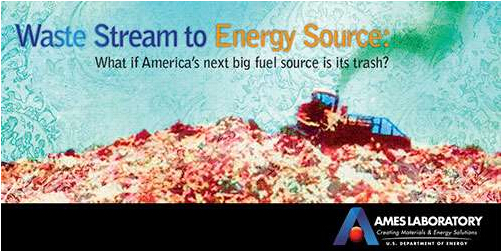
这些问题是美国国家实验室研究人员在合作过程中提出的,他们希望创建能源转换技术,这项技术旨在从废物处理过程中获取碳,从传统意义上说,碳是我们这个星球上的环境负担,也是令人类头痛的废品。
“利用垃圾作为能源确实不是什么新颖的想法,” 辛西娅 詹克斯说,她是艾姆斯实验室科学规划部副主任,也是化学和生物科学分部主任。“例如,一些城市和地区利用已经焚烧的垃圾废物作为电力来源。但是我们认为,还应该有更好的、更清洁和更有效的方式来获取碳,并利用它的潜在能量。
2015年,在美国能源部和能源部实验室举办的大创意峰会上,产生了一个新的概念。这次努力,是由艾姆斯实验室和太平洋西北国家实验室共同领导下,联合了美国12家国家实验室的一项合作,目的是发明一种新的催化技术,可以有效地从废物流中生产生物燃料。
目标很具体。使技术尽可能简单,还要适用于不同的废物流。技术定位就是废物流,无论它是垃圾填埋场、畜牧场,或商业设施。通过模块化制造方法,使其容易、经济的生产和运输。
“这项技术开发需要多学科共同努力:化学研究、应用工程、模块化制造、废物管理、工业、工业和能源部门投资者。这项复杂研究具有多重益处,但我们认为,其中一个好处是提高了我们从这些未充分利用的资源中获取潜在能源的可能性,以及更加接近国家可持续能源生产目标,”詹克斯说。
为了完成这个目标,所有参与研究的国家实验室都将竭尽所能,发挥他们在材料和化学科学、高性能计算、工程和应用技术方法的特长。艾姆斯实验室将通过化学催化与生物科学分部发挥它们在催化研究方面的专长。Igor Slowing和亚伦 萨多两位科学家已经在生成能够转化碳的催化剂方面做了大量工作,具体做法是将催化剂放置在高比表面积的纳米材料上。他们想要开发一种工艺,可以将废聚合物控制分解成有用的碳氢化合物,
“大量进入垃圾场的垃圾是聚合物,如塑料。这些垃圾都富含碳,是已加工材料,如果我们能够将这些废物转化成新的、有利用价值的化合物或能源,就能更好地利用它们。现在,我们把这些碳都浪费了。它们就在垃圾堆里。”亚伦 萨多说。
萨多和Slowing也将采用类似技术来转化湿污泥和农业废弃物。
萨多说科学面临的挑战是复杂的,需要一种在低温低压下操作、高效的化学反应。这些化学反应也需要适应这样一种情况,即发生反应的原材料是不断变化的。
“任何废物流都是高度混杂的,其组成成分随时间而变化,”萨多说。“我们可以从物理特性上进行分类,然后转化,有一个分离步骤。一般来说,我们并不知道如何从化学性质上转化混合物。这是一个非常大、非常有趣也是最根本的一项挑战,目前本研究还没有解决这个问题,要去周密思考这个问题非常令人兴奋。”
这个大的研究团队估计,本地化的生物燃料精炼厂将生产少量的生物燃料,大约相当于每天125桶石油,但是这个集合效应可能是惊人的。将国家可利用的废物流转化成燃料和其它有用的化学产品,每年能够转化成相当于27亿桶石油,或美国每年原油消耗量的40%。
“这确实是一个‘大创意’,”詹克斯说。“哪里有废物,哪里就有能源。我们相信,集合美国各个国家实验室的集体智慧,包括艾姆斯实验室化学研究的优势,这一伟大的创意触手可及。”
英文原文:
What if America's next big fuel source is its trash?
According to the U.S. Environmental Protection Agency, the United States produced 254 million tons of municipal solid waste in 2013. And though 87 million tons of that material from the landfill was diverted through recycling and composting, what if the nation could do better? What if landfills could become local sources of clean energy production? Better yet, what if all waste streams, like those from agricultural, livestock, and food production, could essentially become fuel refineries at a local level?
It's a question being asked by a collaboration of National Laboratory researchers who want to create energy conversion technologies designed to mine the carbon out of waste processes that traditionally have been an environmental burden to the planet and a disposal headache for humans.
"The idea of using waste as energy source really isn't new," said Cynthia Jenks, Assistant Director of Scientific Planning and Division Director for Chemical and Biological Sciences for the Ames Laboratory. "For example, some municipal and regional utilities already burn landfill waste as a source for electrical power. But we think there are better, cleaner, and more efficient ways to get at that carbon and use the potential energy from it."
A new concept was born of the Big Ideas Summit, held by the Department of Energy and its National Laboratories in 2015. The effort, being co-led by Ames Laboratory and Pacific Northwest National Laboratory, is a collaboration of 12 national laboratories to find new catalytic technologies that can efficiently produce biofuel from waste streams.
The goals are specific. Make the technology as simple as possible, yet adaptable to diverse waste streams. Locate it right at the waste stream source, whether it's a landfill, livestock farm, or commercial facility. Make it easy and economical to produce and deliver through the use of modular manufacturing.
"The idea brings together a lot of overlapping interests: chemical research, applied engineering, modular manufacturing, waste management, agriculture, industry, and energy sector investors. It's a complex idea with a lot of moving parts, but one that we think will get us a lot closer to accessing the potential energy in these underused resources, and a lot closer to the nation's sustainable energy production goals," said Jenks.
To meet the goal, the participating National Laboratories will pool their skills in materials and chemical sciences, high performance computing, engineering, and applied technology. Ames Laboratory will lend the project its expertise in catalysis through its Chemical and Biological Sciences Division. Scientists Igor Slowing and Aaron Sadow have already done extensive work in creating catalysts that are able to convert carbons, by placing catalytic agents on high surface area nanomaterials. They want to develop processes that make possible the controlled decomposition of waste polymers into useful hydrocarbons.
"A large amount of the waste that goes into landfills is polymers…plastics. These are very carbon rich, very processed materials, and if we were to be able to convert that waste into new, useful compounds or energy, that would make much better use of them. Right now, we're wasting all that carbon. It's just sitting there in the trash." Aaron Sadow.
Sadow and Slowing will also be applying similar techniques to the conversion of wet sludge and agricultural wastes.
Sadow said the scientific challenges are complex, with a need for chemical reactions that can be highly efficient, operating at low temperature and low pressure. They will also need to be capable of adapting to changes in the raw material feeding them.
"Any waste stream is very mixed, and its composition varies over time," said Sadow. "We can physically sort and then convert, but then there's that separation step. We don't really know how to chemically convert mixtures in general. That is a really big, interesting, fundamental challenge that research hasn't yet tackled, and that's exciting to contemplate."
While the group estimates that these localized biofuel refineries would produce small quantities of biofuel, an average of the equivalent of 125 barrels of oil per day, the collective impact could be staggering. Transforming the available national waste streams into fuels and other useful chemical products could translate to the equivalent of 2.7 billion barrels of oil per year, or 40 percent of the nation's annual crude oil use.
"That's really the 'big idea,'" said Jenks. "wher there is waste, there is energy. We believe that the collective expertise of the national labs, including the chemical research strengths of Ames Laboratory, puts that big idea within reach."
